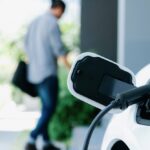
Kitchen sink carriers: EVs with the biggest boot space
23 September 2024
Three ways to counter the “I can’t afford it” objection in EV sales
23 September 2024Your guide to buying a used EV
Buying any used car can feel like a leap into the unknown. Will it turn out to be a lemon? Did the last owner drive it like they stole it? Is the price right?
When it comes to buying electric vehicles (EVs), there’s also the fact that the technology is new to a lot of drivers. You’ve probably got a few questions you’ve never had to consider before.
This Guide to Buying a Used EV will help answer all those niggling questions. It will help you get stuck into the world of low cost, low carbon, and high-tech EV motoring with confidence.
We’ll cover:
- The used EV market.
- What to look for when buying a used EV.
- Should you worry about the battery?
- What you can get for your money.
- Getting your home charging sorted.
The used EV market
When any new technology is launched, it takes time for the second-hand market to develop.
The eager early-adopters acquire new, and a little while down the line they’ll upgrade and either sell on their original purchase or return it if it was leased.
From there it’s a snowball effect. As more second-hand examples come up for sale, more people get interested in buying them.
That’s exactly what’s happened with EVs. With new EVs selling well for a few years now, the second-hand market is shaping up nicely.
In fact, they’re selling like hotcakes.
Sales are booming
According to the Society of Motor Manufacturers and Traders, April to June 2023 saw sales of used battery electric vehicles (BEVs, or fully electric vehicles) rocket by a whopping 81.8%.
By comparison, the overall used car market grew by 4.1% during the same period. The EV market is supercharged. It’s like a Tesla Roadster racing a Reliant Robin.
Prices are affordable
There’s good news on the price front too.
Fleet News reports that used EV prices have plummeted in recent years, as vehicles bought new three or four years ago have started to come onto the market.
The most recent data shows prices are still falling, but they’re stabilising —a sign that the market has established itself.
Used EV prices are now on a par with petrol and diesel—while being significantly cheaper to run.
According to Auto Trader data, the price gap between EVs and their gas guzzler equivalents has closed too.
In many cases, the electric version is cheaper than its fossil fuel sibling.
Yep, you read that right. You’ll pay more for an aging, dirty, soon-to-be-banned car than for a state-of-the-art, low-cost, low-carbon one.
According to the data, a three-year-old Mini Hatch petrol car sold for an average of £18,514 in August 2023. A three-year-old BMW i3 electric car, similar in terms of size and desirability, sold for an average of £18,090 in the same month.
Second-hand bargains, lower running costs, a better driving experience, and a significantly lower carbon footprint. Making the switch to EV is fast becoming a no-brainer.
EVs are overtaking gas guzzlers when it comes to value:
|
What to look for when buying a used EV
It pays to give any used car a thorough once over before you buy. With an EV, pay attention to all the usual things, plus a few extras.
Assess the condition of the tyres, bodywork, and brakes. Brake discs and pads are used less in electric cars because of regenerative braking, so chances are they’ll be fine (but it’s still important to check).
What is regenerative braking?Most EVs use regenerative braking. It’s when resistance in the electric motor helps slow the car down, reducing the stress on your brake pads and discs. It reduces brake dust pollution and also creates an electric current that tops up your battery. Clever, huh? |
Look at the mileage and service history too. Electric cars require less servicing than gas guzzlers. But a good service history is still a sign that the previous owner has been attentive and dealt with any problems.
Check the condition of the electric charge socket to make sure it’s not been damaged. Make sure any charge cables the car needs are there. If you need to buy a cable separately, it can be expensive.
When you take the car for a test drive, make sure there are no dashboard warning lights on, and listen out for any rattles or knocks. EVs cruise along quietly, so any untoward noises should be easy to pick up.
Test the brakes carefully too. Make sure the regenerative braking is working as it should be.
And finally, you should, of course, check the battery range and health.
Should I worry about the battery when buying a used EV?
Fortunately, the myth that EV batteries don’t last isn’t true. Apologies in advance to the naysayers, but the mythical warehouses full of cooked EV batteries just don’t exist.
A study by Recurrent Auto’s team of battery scientists has shown that almost all EVs still have their original batteries, and they’re doing just fine.
As with every battery ever made, some fade in performance is unavoidable. It’s usually a tiny amount and it’s not linear.
The battery power tends to dip a small amount when the car is first used, but then it stabilises nicely.
EV manufacturers predict batteries will last up to 20 years, and most offer a battery warranty that’s longer than on other parts of the car. The battery warranty offered by major brands such as VW, BMW, and Tesla is typically around 8 years or 100,000 miles.
That means anybody buying a three-year-old car on a typical mileage has still a long runway before the battery warranty runs out.
Checking the battery health
The battery is an expensive component in an electric car, so it’s important to check it nonetheless.
Many EVs have a Battery Management System that keeps an eye on the battery’s health. It monitors the voltage, current, and temperature and uses that data to give you a reliable indication of the overall condition of the battery.
You can also ask the seller to show you the car with the battery fully charged and compare the estimated mileage available with the manufacturer’s claimed range. If it’s significantly lower, it’s an indication that the battery isn’t in good health (though chances are that won’t be the case).
Finally, on a test drive, compare the estimated range in the battery with the miles you actually get out of it. If the estimated range falls a lot faster than the miles you drive, something might be up.
What can you get for your money?
So, what sort of ride can you expect to get for your budget?
We mined Autotrader ads to see what type of cars are on offer for three different budget levels (prices correct as of October 2023).
Under £10,000
It’s possible to get a great EV for under £10,000 these days. At this price point, the battery range won’t be huge, so they’re best suited to shorter daily journeys, such as commuting or ferrying the kids to and from school.
But, given that the average UK car drives just 142 miles per week, you’re still likely to get more than enough range for day-to-day driving—especially if you’re able to charge at home.
For under £10,000, you can pick up a Renault Zoe, Smart Forfour, or an older Nissan Leaf or BMW i3.
It depends on a few factors, but a five year-old Renault Zoe with fewer than 40,000 miles on the clock would be well within your budget.
One thing to note when looking at cars in this price bracket: some require you to pay an additional monthly fee to lease the battery (usually between £50 to £100).
Battery leasing was popular with older EVs because it reassured drivers that they could get a replacement without paying anything extra (because they didn’t own the battery themselves). Nowadays, with fears around battery life put to bed, battery leasing isn’t as common.
£10,000 to £15,000
With a budget of £10,000 to £15,000, you’re getting into larger hatchback and SUV territory, as well as newer models with lower mileage. You’ve also got a lot more choice.
You can, for example, pick up an MG Zs SUV with 28,000 miles on the clock and a manufacturer’s advertised range of 163 miles, and still have some spare change for fluffy dice and air fresheners.
Other cars available in this price bracket with fewer than 50,000 miles on the clock include:
- Volkswagen e-Golf
- Hyundai Ioniq
- Mini Electric
- Vauxhall e-Corsa
- Peugeot e-208
- Newer BMW i3s
- Newer Nissan Leafs
Over £15,000
With a budget of over £15,000, your options really open up.
The sky’s the limit and, depending on how high you go, you could be driving an electric supercar with a range of 300+ miles.
All the major brands are represented in this price bracket, including newer EV-specific makes such as:
- Tesla
- Polestar
- Cupra
As an example, a 2018 Tesla Model S with just under 50,000 miles on the clock and a manufacturer’s advertised range of 300 miles can be had for £30,000.
Get your home EV charging sorted
Setting yourself up to charge at home will transform your EV experience.
Buying an electric car but skipping the EV home charger is like booking a posh hotel but skipping the breakfast. You’ll enjoy it, but you’ll look longingly at the other guests enjoying warm croissants and barista coffee every morning.
With a home charger, you can charge at home at your own convenience instead of relying on expensive public charging.
You can leave your EV charging overnight and wake up to a fully charged battery the next day, with no need to drive halfway around town to top up at a charging station.
Smart EV chargers optimise your charging. Using an app (such as our very own Raya Energy Assistant), you tell the charger the time your car needs to be topped up by, and it’ll do the rest.
If you’re on a cheaper night-time electricity tariff, it’ll make sure you’re making the most of that too. It can even suggest alternative tariffs based on when you usually charge, to maximise your savings.
EV charging with solar: the gold standard.
Combining a home EV charger with solar panels means you can charge your car with zero-cost and zero-carbon energy.
A setup with about 8-12 panels will be enough to charge a typical EV.
A few factors come into play, such as the size of your EV’s battery and the weather. But even when the sun isn’t out, you’ll still generate some electricity. Solar panels just need daylight to work, not blazing sun (though that’s when they work best, of course).
Smart EV chargers can detect when your solar panels are generating electricity and focus charging during those times, so you make the most of the free energy.
The final word on used EVs
There’s no need to be nervous about buying a used EV nowadays. The market has matured and there are some real bargains to be had.
The batteries are lasting well and there are no signs that older EVs need to have them replaced.
Home EV charging technology has also come a long way. With the right setup, you can fit charging around your lifestyle, and use smart technology to maximise cost savings and convenience.
About Powerverse
We’re industry experts in home energy management. Our easy-to-use app is built for your future electric home. It will effortlessly sync your solar, battery, heat pump, EV charger and more, helping you cut costs and your carbon footprint on your way to becoming energy-independent. Curious to know more? Talk to one of our experts.

